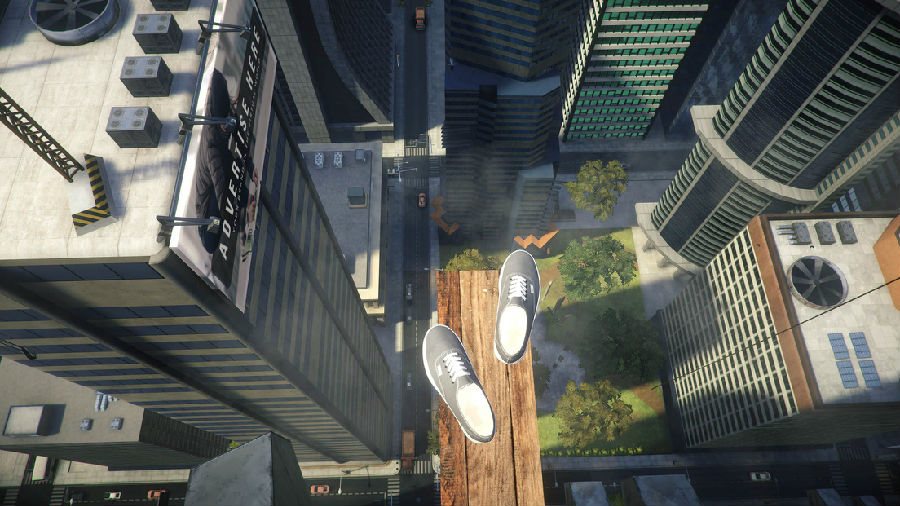Oh. Oh, damn. Ohhhhh.
哦,哦,该死,哦。
Holy! These people are panicking because they're being asked to step out of an elevator onto a single plank that's suspended 80 stories in the air.
天哪!这些人惊慌失措,因为要求他们走出电梯,走到一块悬挂在空中80层的木板上。
Oh, man. This game is called Richie's Plank Experience and by their very real reactions you might expect some groundbreaking, photorealistic visuals behind that headset.
哦,伙计。这个游戏名叫“里奇的木板体验”,根据他们的真实反应,可以判断出他们可能会在头盔后面看到一些突破性的、真实感的视觉效果。
Oh! God! No!! But that's really not the case - Sure, it's nice, but it's clearly not real.
哦!上帝啊!不!!但这并非现实——当然,这很好,但显然不是真的。
The graphics are really beautiful but the lighting isn't quite right - things are just a little too diffused.
图形真的很漂亮,但灯光不是很对——太分散了。
The buildings are almost too smooth.
这些建筑物太光滑了。
The plants on the ground are clearly squared off.
地上的植物明显成了正方形。
It's hard to believe these people aren't dramatizing their reactions for the camera. Oh! God!
很难相信这些人没有在镜头前夸张他们的反应。哦!上帝啊!
But it's not just the plank experience.
但这不仅仅是木板体验。
The internet is full of VR fails where people are sucked into pixelated worlds with disembodied parts in front of them.
互联网上到处都是虚拟现实,人们被吸入到像素化的世界里,面前是虚无缥缈的部分。
But this really got me thinking - How is it that a virtual world that doesn't look very real at all, feel so real?
但这引发了我的思考——一个看起来并不真实的虚拟世界怎么会感觉如此真实?

Of course, the first major difference between watching VR and being in it is putting on the headset.
当然,观看虚拟现实和置身其中的第一个主要区别是戴上头盔。
Here's where VR marketing has mostly failed. Right?
这就是虚拟现实营销最失败的地方,对吗?
Because it's always shown from a spectator's perspective.
因为它总是从旁观者的角度来看。
And as a spectator, you do not get the experience of the person in VR.
作为一个旁观者,你不能在虚拟现实中获得这个人的体验。
Thong Nguyen is the founder and CEO of Roomera, a company that helps businesses test and understand new spaces before they're built using virtual reality.
Thong Nguyen是Roomera的创始人和首席执行官,该公司是一家帮助企业在使用虚拟现实构建新空间之前测试和了解新空间的公司。
V.R. communicates to your brain in a different way than looking at a screen.
虚拟现实与你的大脑交流的方式与看屏幕不同。
When looking at a screen - like our TV or phone - our brains read this as a flat image in the same way we would view a picture.
当我们看电视或手机等屏幕时,我们的大脑将其视为一个平面图像,就像我们看图片一样。
If an object on a screen gets bigger or smaller or a person on TV moves toward the camera you don't feel the need to take a step back or move out of their way,
如果屏幕上的物体变大或变小,或者电视上的人朝摄像机移动,你就不需要后退一步或让开他们的路,
but in VR you might want to because you're not looking at one screen - You're looking at two - And those two screens are literally right in front your eyes.
但在虚拟现实中,你可能会这样做,因为你看的不是一个屏幕,而是两个屏幕,而这两个屏幕就在你眼前。
Projecting a slightly different image into each eye.
向每只眼睛投射一个稍有不同的图像。
Which is how our vision works in the real world - each eye takes in stimuli from a slightly different vantage point.
这就是我们的视觉在现实世界中的工作原理——每只眼睛从一个稍微不同的有利位置接受刺激。
You can test this: Hold your finger up in front of your face and wink each of your eyes.
你可以测试一下:把你的手指举到你的面前,眨眨眼。
Your finger should "jump" back and forth.
你的手指应该是来回“跳跃”的。
That "jump" is the difference between what your left and right eye are seeing.
“跳跃”就是你的左眼和右眼看到的东西之间的区别。
The differences between what your eyes see conveys depth. It conveys three dimensions.
你眼睛看到的东西之间的差异传达了深度,它传达了三个维度。
This is known as stereopsis and VR developers have spent a lot of time perfecting it.
这就是众所周知的立体视觉,虚拟现实开发人员花了很长时间来完善它。
But what use is depth if you can't move through it?
但如果你不能走出来,这个深度又有什么用呢?
Which brings us to the next most important way virtual reality tricks your brain:
这就引出了虚拟现实欺骗你大脑的另一个最重要的方式:
you are the camera and it's fast enough where your brain starts interpreting it as your perspective.
你就是摄像机,它足够快,你的大脑开始把它解释为你的视角。











